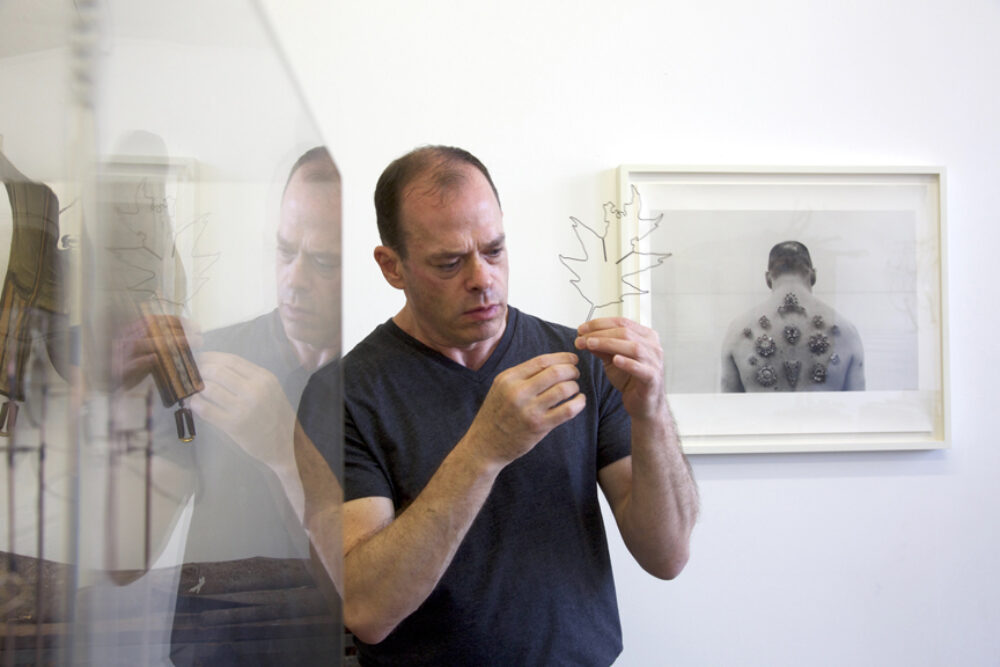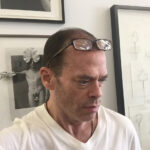The 12th annual Visual AIDS Vanguard Awards (VAVA Voom) recognize the contributions of individuals who, through their work, talent and dedication, strengthen our communities and reinforce the mission of Visual AIDS. This year Visual AIDS is proud to honor Zoe Leonard, Sur Rodney (Sur) and Eric Rhein and recognize Brice Brown.
Eric Rhein’s work chronicles his life experience and travels, both geographic & mystic; his childhood in the Appalachian Mountains and New York’s Hudson Valley, and his nearly three decades living with HIV. After his diagnosis in 1987, Rhein began exploring themes of vulnerability, resilience and transcendence. In 1996, the year protease inhibitors restored Rhein’s physical vitality, he began his ongoing series, Leaves, which honors the lives of over 250 men and women he knew who died of complications from AIDS. Leaves continues to evolve and be shown internationally. Here, Visual AIDS interviews former Programs Manager Ted Kerr about Eric's important art, archives and studio.
Visual AIDS: You recently conducted an oral history with Eric for the Smithsonian Archives of American Art's "Visual Art & the AIDS Epidemic Oral History Project." What was that experience like, and what did you learn?
Ted Kerr: Honestly, it was a spiritual experience. A thread throughout Eric's life is his stewardship of the light, that essence which passes through and between us all, often best captured by a brief smile between strangers on a dance floor, the sight of a hummingbird mid flight, or the experience of art however you may encounter it. As someone living long-term with HIV, Eric does not take his light for granted. He knows how easily it can be extinguished, and not just through loss of life, but also through abuse and neglect. Throughout his life Eric has fought to maintain his spark, and support others as they do the same.
Our last interview for the project occurred on Easter Sunday, a detail not lost on either of us as he narrated, at my request, the meaning behind his landmark photograph “Lazarus - Self Portrait” 1997, a self portrait of a man whose life and spirit was renewed after the introduction of life saving medication and amid the glow of being truly seen by a friend.
Visual AIDS: Eric has a rich history with Visual AIDS, as a founding member and one of "The First 10" artists of The Archive Project, and much more. Can you speak to Eric's investment in the organization and its mission?
Ted Kerr: Eric holds a special place in American culture. Along with artists like Nancer LeMoins, Fred Weston, and Jose Luis Cortes, he has lived long-term with HIV, been public about his positive status from very early on, and carved out a meaningful and rich career as an artist. This is a tremendous feat. And, as we know the work continues. Visual AIDS has done amazing work in reducing stigma within the art world and beyond by supporting artists living with HIV, and tasking institutions to get involved. Yet still, there is much to do. Many artists are understandably afraid to be out about their status, in part because so many curators and administrators still attempt to downplay the role that the virus plays within an artist’s life and in the content of their work. Amidst all this, Eric shows us that an artist can be out about their positive status and still be nationally and internationally exhibited, and celebrated - if they have support from friends, family, and a small but mighty art organization.
I should also say that Eric’s work speaks to the twin missions of Visual AIDS: to remember and support. Eric’s project, “Leaves” (1996 - present) is an elegant, ongoing and unique form of remembrance, in which the individuality of a person’s life and their passing is acknowledged. Alongside that project is the importance of Eric’s decades long practice of self portraiture, a vital form within minoritized and villainized communities. Like similar projects by Kia Labeija and Albert Winn, his practice of self reflection and self representation push back against circulating negative images and of course absence. Bridging the leaves and the portraits is Eric’s ever evolving sculptural work, which queers the form forward. Slight whispers of wire constitute large bodies and emotionally heavy ideas. Seeing these three streams together, it is clear that Eric is an important artist in his own right, and is a powerful and beautiful presence within the Visual AIDS registry.
Visual AIDS: As the former Programs Manager at Visual AIDS yourself, describe when you worked most closely with Eric?
Ted Kerr: A few years ago I had the chance to meet Eric’s mother Shelbiana, and sister, Jamie. Both are warm, blunt and gregarious women. They could just as easily talk bussing companies to change their racist policies (as Shelbiana once did) as they could talk you into going skinny dipping. I saw this side of Eric first in 2013. That year I had the pleasure of assisting Visual AIDS artist members as they delivered art making workshops to youth across Manhattan, the Bronx and Staten Island as part of the NYPL’s WHY WE FIGHT exhibition (curated by Jason Baumann Montilla). Although I was not able to admit it at the time, this was nerve-wracking to me: Kids creep me out! Luckily, the first workshop was with Eric, and he set the tone of the wonderful weeks that would follow. He was such a natural educator and communicator with the youth—and me! It was pure delight to be part of the experience in which me and the grade school youth sat around a small table with Eric teaching us how to make leaf portraits, while leading us through a discussion about family, death and art.
Visual AIDS: Eric's work explores both mystic and transcendent themes while also remaining grounded in the vitality of the lived experience of a long-term survivor. Can you speak to these themes?
Ted Kerr: I hope there is some amazing academic, activist, curator or artist joining Nathan Lee in his previous work thinking about undetectable. And I hope that they find a foundation within Eric’s work. From Silence = Death to #blacklivesmatter to Laura Poitras’ films to Demian DinéYahzi’s print work and photography to the praxis of Dean Spade to Sunil Gupta’s images and exhibitions to Kara Walker’s "A Subtlety" to Ultra Red’s invitation to relate, we can see that if the late 20th / early 21st century is about anything, it is about wrestling with what it means to be perceptible and to be not; to be valued and to be not; and what role systems and states play in these decisions, and how we live and die.
In a quiet way, much like the artist Frank Moore, Eric has long been part of this conversation. His sculptures from 1987–89 are minimal breastplates, an expression of both a desire to survive and be seen. Implicit questions emerge: will my vulnerability kill me? How much do I have to hide of myself to protect myself? Most recently, Eric is navigating what it is to die, and what it is to live long-term with HIV. His leaf for activist Spencer Cox is especially poignant. Here was a man living a visible life with HIV, and for complex reasons, Cox made the choice to slowly die, a death hiding in plain sight. His passing was a crushing blow to those who knew him and knew of him. Through Eric’s gentle hand we can complicate the powerful activism emerging around the undetectable movement by asking, what does the call to become undetectable mean for communities who already feel silenced, sidelined and marked for extinction? Can we make room to discuss the ways in which viral loads and life chances are already conflated? How do we make room for people to be sick, visible as they want to be and valued?
Visual AIDS: Are there artworks by Eric that particularly resonate with you?
Ted Kerr: If there must be a cannon, let it at least include Chloe Dzubillo’s work, “Untitled (There is a Transolution),” and “Silver Horizon" (2010) by Eric Rhein. It is a black and white photograph of Eric’s back from behind in 2010, with the bay of Fire Island on the horizon. On his back are 13 jeweled broaches, arranged as if a family tree with one beautiful life source resting just below the nape of his neck. At first look, I thought "Horizon" was an expression of the many ways HIV leaves it’s mark on a body: lesions, damaged organs, ongoing sorrow. In speaking with Eric I found out that like his work “Lazarus,” “Horizon” can actually also be read as a resurrection allegory in which the viewer’s gaze, the lens, and our reflection in the glass are the three women rendered speechless at the cave, witnessing the miracle of enduring life. Hiding his face, rare in his self portraits, Eric is proud of his survival, but also bashful, and maybe a bit overwhelmed. And then, through further conversation with Eric, I came to see how the work also lends itself to relate to many people's experience: Here is a body, filled in over time, pushed down by gravity, looking at all that is still yet to come.
Visual AIDS: What is it like to experience Eric's artist studio?
Ted Kerr: Eric recently moved into his studio at Mana Contemporary in New Jersey. It is a beautiful complex run by people that respect the fact that artists need access to space and beauty to create. Within this setting, Eric has recreated his east village studio including handsome wood dressers and shelves holding wire, crystals and other material. In front of a wall of windows at the back of his studio is a huge table in which ever changing curated piles of ephemera rest. There you find pictures of Eric’s legendary Uncle Lige Clarke and his partner Jack Nichols; antique postcards; to do lists and handsome books from the 1950s onward. And of course, there is his art work: on full view and stored. A visit to his studio is a window into how wonderful a retrospective of Eric Rhein’s work would be.
Visual AIDS: Describe Eric Rhein in one sentence.
Ted Kerr: I will do a haiku instead:
A life captured in
wire and gelatin, a
love cut with duty
Eric Rhein received his BFA and MFA from SVA. International exhibitions include the Victoria and Albert Museum; Pera Museum, Istanbul; 21er Haus Museum of Contemporary Art, Vienna; American Embassies in Austria, Cameroon, Greece, and Malta; the Addison Gallery of American Art; the Leslie-Lohman Museum of Gay and Lesbian Art; Lincoln Center, Artists Space; Art in General; Sculpture Center; White Columns; The Bronx Museum of the Arts; and the Smithsonian. Reviews of Rhein’s work have appeared innumerous publications, including The New York Times, Art News, and Art in America. Grants and fellowships include the Pollock/Krasner Foundation, Art Matters,and the MacDowell Colony. www.ericrhein.com
Canadian born Theodore Kerr is a Brooklyn based writer, organizer and artist. He was the programs manager at Visual AIDS. In 2016 he graduated with his MA in Theology from Union Theological Seminary. Last year he was awarded the Best Journalism award from POZ Magazine for his Hyperallergic article on race, HIV/AIDS and art. He is a founding member of What Would an HIV Doula Do? and is a member of the New York City Trans Oral History project. He currently teaches at The New School.











